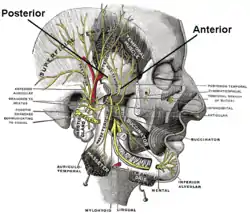The deep temporal nerves are typically two nerves (one anterior and one posterior) which arise from the mandibular nerve (CN V3) and provide motor innervation to the temporalis muscle.
| Deep temporal nerves | |
|---|---|
 Mandibular division of the trigeminal nerve | |
| Details | |
| From | Anterior division of mandibular nerve |
| Innervates | Temporalis, temporomandibular joint |
| Identifiers | |
| Latin | nervi temporales profundi |
| TA98 | A14.2.01.071 |
| TA2 | 6254 |
| FMA | 53187 |
| Anatomical terms of neuroanatomy | |
Structure
Origin
They usually arise from (the anterior division of) the mandibular nerve (CN V3).[1][2]
Course
They pass superior to the superior border of the lateral pterygoid muscle.[1] They ascend to the temporal fossa and enter the deep surface of the temporalis muscle.[2]
Distribution
The deep temporal nerves provide motor innervation to the temporalis muscle. The deep temporal nerves also have articular branches which provide a minor contribution to the innervation of the temporomandibular joint.[3]
Variation
Number
There are usually two deep temporal nerves - the anterior deep temporal nerve and posterior deep temporal nerve. Occasionally, a third one is present - the middle deep temporal nerve.[2]
Origin
The anterior one may arise from the buccal nerve, and the posterior one may arise from the masseteric nerve.[2]
References
- 1 2 Sinnatamby, Chummy S. (2011). Last's Anatomy (12th ed.). Elsevier Australia. p. 364. ISBN 978-0-7295-3752-0.
- 1 2 3 4 Standring, Susan (2020). Gray's Anatomy: The Anatomical Basis of Clinical Practice (42th ed.). New York. pp. 680–680.e1. ISBN 978-0-7020-7707-4. OCLC 1201341621.
{{cite book}}: CS1 maint: location missing publisher (link) - ↑ Gray, Henry (2015). Gray's Anatomy : The Anatomical Basis of Clinical Practice. Standring, Susan (41 ed.). Philadelphia: Elsevier. pp. 544, 551. ISBN 978-0-7020-5230-9. OCLC 920806541.